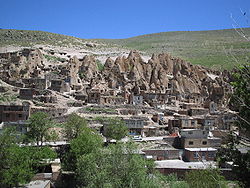Kandovan, Osku
|
Kandovan كندوان |
|
|---|---|
| village | |

A view of Kandovan rock houses.
|
|
| Coordinates: 37°47′42″N 46°14′55″E / 37.79500°N 46.24861°ECoordinates: 37°47′42″N 46°14′55″E / 37.79500°N 46.24861°E | |
| Country |
|
| Province | East Azerbaijan |
| County | Osku |
| Bakhsh | Central |
| Rural District | Sahand |
| Population (2006) | |
| • Total | 601 |
| Time zone | IRST (UTC+3:30) |
| • Summer (DST) | IRDT (UTC+4:30) |
Kandovan (Persian: كندوان, also Romanized as Kandovān and Kandavān; also known as Kanvān) is a village in Sahand Rural District, in the Central District of Osku County, East Azerbaijan Province, Iran. This village exemplifies manmade cliff dwellings which are still inhabited. The troglodyte homes, excavated inside volcanic rocks and tuffs similar to dwellings in the Turkish region of Cappadocia, are locally called "Karaan". Karaans were cut into the Lahars (volcanic mudflow or debris flow) of Mount Sahand. The cone form of the houses is the result of lahar flow consisting of porous round and angular pumice together with other volcanic particles that were positioned in a grey acidic matrix. After the eruption of Sahand these materials were naturally moved and formed the rocks of Kandovan. Around the village the thickness of this formation exceeds 100 m and with time due to water erosion the cone shaped cliffs were formed. At the 2006 census, the village population was 601, in 168 families.
Far view of a hotel on the left and the rock houses on the right
Closer view of the village
In the village
In the village
Interior of a traditional home
View of the village and surroundings from the rock houses
...
Wikipedia

